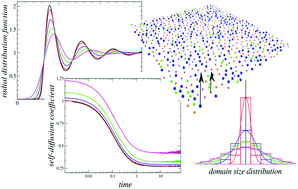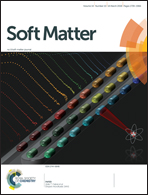Domain size polydispersity effects on the structural and dynamical properties in lipid monolayers with phase coexistence†
Abstract
In lipid monolayers with phase coexistence, domains of the liquid-condensed phase always present size polydispersity. However, very few theoretical works consider size distribution effects on the monolayer properties. Because of the difference in surface densities, domains have excess dipolar density with respect to the surrounding liquid expanded phase, originating a dipolar inter-domain interaction. This interaction depends on the domain area, and hence the presence of a domain size distribution is associated with interaction polydispersity. Inter-domain interactions are fundamental to understanding the structure and dynamics of the monolayer. For this reason, it is expected that polydispersity significantly alters monolayer properties. By means of Brownian dynamics simulations, we study the radial distribution function (RDF), the average mean square displacement and the average time-dependent self-diffusion coefficient, D(t), of lipid monolayers with normally distributed size domains. For this purpose, we vary the relevant system parameters, polydispersity and interaction strength, within a range of experimental interest. We also analyze the consequences of using a monodisperse model to determine the interaction strength from an experimental RDF. We find that polydispersity strongly affects the value of the interaction strength, which is greatly underestimated if polydispersity is not considered. However, within a certain range of parameters, the RDF obtained from a polydisperse model can be well approximated by that of a monodisperse model, by suitably fitting the interaction strength, even for 40% polydispersities. For small interaction strengths or small polydispersities, the polydisperse systems obtained from fitting the experimental RDF have an average mean square displacement and D(t) in good agreement with that of the monodisperse system.



 Please wait while we load your content...
Please wait while we load your content...